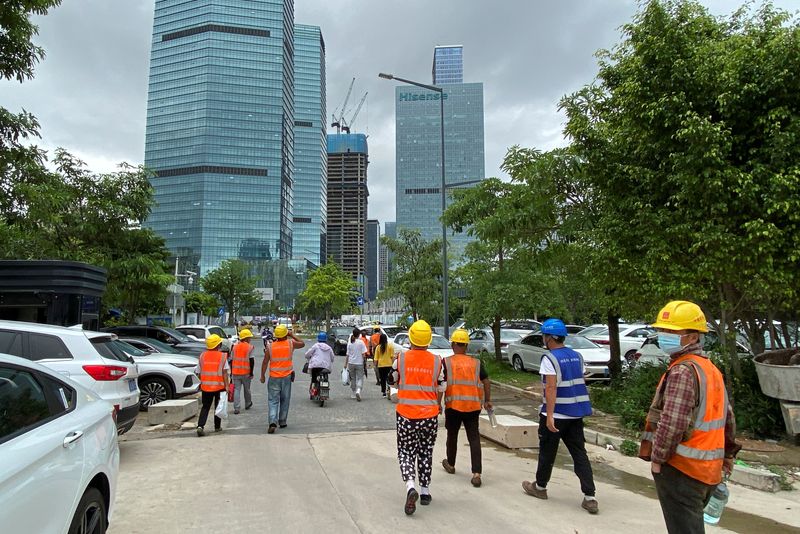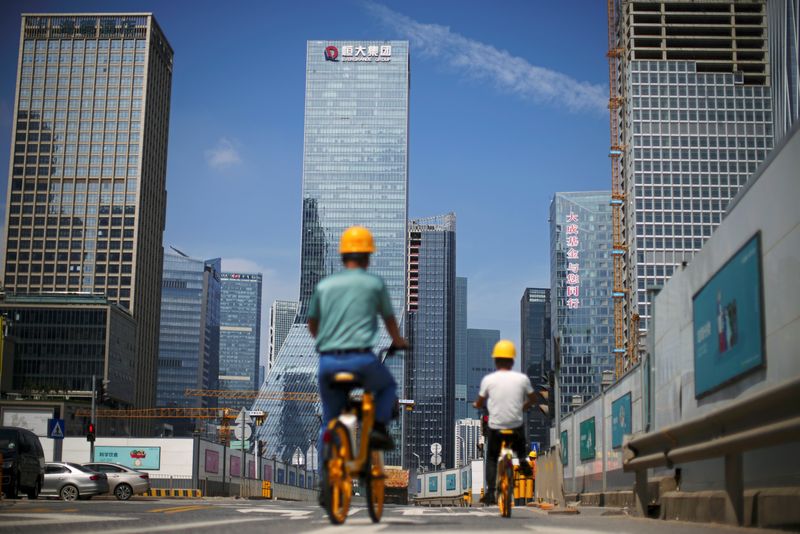(This June 12 story refiles to clarify location in penultimate paragraph)
By David Kirton
SHENZHEN, China (Reuters) - David Fong made his way from a poor village in central China to the southern boomtown of Shenzhen as a young man in 1997. Over the next 25 years he worked for a succession of overseas manufacturers before building his own multi-million dollar business making everything from schoolbags to toothbrushes.
Now 47, he has plans to branch out internationally by building internet-connected consumer devices. But after two years of coronavirus lockdowns that have pushed up the price of shipping and battered consumers' confidence, he worries if his business will survive at all.
"I hope we make it through the year," said Fong, surrounded by talking bears, machine parts and his company's catalogues in his top-floor office overlooking gleaming towers in an area of Shenzhen once filled with sprawling factories. "It's a tough moment for a business."
Fong's story of rags to riches, now threatened by a wider slowdown worsened by the coronavirus, mirrors that of his adopted city.
Created in 1979 in the first wave of China's economic reforms, which allowed private enterprise to play a role in the state-controlled system, Shenzhen transformed itself from a collection of agricultural villages into a major world port that is home to some of China's leading technology, finance, real estate and manufacturing companies.
For the last four decades, the city posted at least 20% annual economic growth. As recently as October, forecasting firm Oxford Economics predicted that Shenzhen would be the world's fastest-growing city between 2020 and 2022.
But it has since lost that crown to San Jose in California's Silicon Valley. Shenzhen posted overall economic growth of only 2% in the first quarter of this year, the lowest-ever figure for the city, aside from the first quarter of 2020 when the first wave of coronavirus infections brought the country to a standstill.
Shenzhen remains China's biggest goods exporter, but its overseas shipments fell nearly 14% in March, hampered by a COVID lockdown that caused bottlenecks at its port.
The city has long been seen as among the best and most dynamic places for business in China and a triumph of the country's economic reforms. President Xi Jinping called it the 'miracle' city when he visited in 2019.
If Shenzhen is in trouble, that is a warning sign for the world's second-largest economy. The city is "the canary in the mine shaft," said Richard Holt, director of global cities research at Oxford Economics, adding that his team is keeping a close eye on Shenzhen.
Fong, who sells his goods mostly to domestic customers, said sales are down about 40% from 20 million yuan ($3 million) in 2020, hurt by the recent two-month lockdown in Shanghai and a general decline in consumer confidence. China's strict travel rules mean he has not been able to visit Europe to try to expand there.
LOSING ATTRACTIVENESS
Shenzhen, now a city of some 18 million people, has been hit by a succession of blows from inside and outside the country.
Shenzhen-based telecom equipment makers Huawei Technologies and ZTE Corp (HK:0763) were placed on U.S. trade blacklists over alleged security concerns and illegally shipping U.S. technology to Iran respectively. Huawei denies wrongdoing, while ZTE exited probation in March five years after pleading guilty.
Another of the city's major companies, top-selling property developer China Evergrande, sparked fears of a collapse last year under its heavy debts that would have wreaked havoc with China's financial system. Down the road, Ping An Insurance Group Co, China's largest insurer, took big losses on property-related investments.
Even smaller firms have suffered. Amazon.com Inc (NASDAQ:AMZN) last year cracked down on how sellers do business on the platform, impacting more than 50,000 e-commerce traders, many based in the city, the Shenzhen Cross-border E-commerce Association said.
On top of that, Shenzhen was locked down for a week in March to prevent the spread of the coronavirus. That lockdown, and those in other Chinese cities, depressed domestic demand for goods made in Shenzhen. The city's 2% growth in the first quarter was less than half of China's overall 4.8% growth rate.
Business registrations also fell by almost a third in that time. City authorities are sticking to their 6% growth target for this year, set in April, but the slowdown has sparked alarm in China's establishment.
"Shenzhen's economy is faltering, leaning back, and sluggish, while some are doubting if Shenzhen has enough momentum," Song Ding, a director at the state-linked think tank China Development Institute, wrote in a May essay.
The Shenzhen government did not reply to a request for comment for this story.
City officials privately admit that it is increasingly difficult to keep Shenzhen's 'miracle' alive.
"There's a lot of people with a stake in Shenzhen remaining predictable, unlike before. You can't just experiment freely and see what sticks anymore," one city official told Reuters, on condition of anonymity.
On June 6, state news agency Xinhua reported that Shenzhen plans to build 20 advanced manufacturing industrial parks for telecoms and high-technology companies that will cover 300 square kilometres (115 square miles). It did not provide any further details.
'TIME TO GO'
The cancellation of most international flights to China, a port snarled by lockdowns and a once-teeming border with Hong Kong that is now all-but-shut have made Shenzhen a difficult place to do business. China's plans for a Greater Bay Area - melding Shenzhen with Hong Kong, Macau and several mainland cities - appear to have stalled.
"It's losing attractiveness, and they (authorities) need to realise that," said Klaus Zenkel, chairman of the European Chamber of Commerce in South China. "We always say they need to balance the restrictions and the economic growth, to find a way to spend more money on the Greater Bay Area and these free trade zones."
In September, the Chinese government said it would expand what is known as the Qianhai economic zone, a special area within Shenzhen's borders, to 121 square kilometres from 15 square kilometres. British banks Standard Chartered (OTC:SCBFF) and HSBC have set up offices there, but border closures mean the area has struggled to attract foreign businesses, Zenkel and five diplomats in the region said.
Overseas entrepreneurs who flocked to Shenzhen to have their designs turned into products no longer make regular visits to its factories and the world's largest electronics market in Huaqiangbei, forcing dozens of expat bars and restaurants to close or adapt to local tastes.
International business chambers have warned the Chinese government of an exodus of foreign talent. One diplomat at a major European consulate told Reuters they estimated the number of its nationals in south China had fallen to 750 from 3,000 before the pandemic.
The slowdown has made it harder for graduates to find jobs in what has long been China's youngest metropolis, where the average resident is 34. The lush, subtropical city that fused manufacturing, technology, and finance into an entrepreneurial hotbed sometimes known as China's Silicon Valley, was a magnet for ambitious and talented graduates from across the country.
"I've interned at companies where classmates a year or two older had found jobs, but it's much harder to land a position than it was for them," said Jade Yang, 22, who completed an advertising degree in May and moved 1,400 kilometres from central Chongqing to find work at a Shenzhen tech firm. She said she initially hoped for a salary of up to 10,000 yuan a month but now thinks 6,000 yuan is more realistic.
In a dense area of apartments near High Tech Park, one of the city's clusters of tech companies, estate agents would normally be swamped with graduates looking to find homes in May. An agent, who gave his name only as Zhao, told Reuters last month that business is down 50% from a year ago.
"This place should be bustling with people, I shouldn't have a moment of rest," he said, lounging on his e-scooter outside a building with 30 studio flats where rent is 2,000 yuan a month. He said several have been empty since November.
Shenzhen businesses have always opened and closed at a high turnover, but 'to let' signs are increasingly common in once bustling malls, especially those close to border crossings with Hong Kong, which have been closed since early 2020.
The situation is bleak for Shenzhen's low-income migrant workers, struggling to get by with rising living costs and locked out of home ownership by some of the highest real estate prices in the country.

Masseuse Xue Juan, 44, said her friend recently returned to her small hometown near Chengdu and opened a hotpot restaurant, and she is thinking of joining her.
"Even food and drink is getting too expensive, the work is hard, and living standards have improved so much in the rest of China," said Xue. "Maybe it's time to go."
